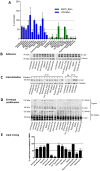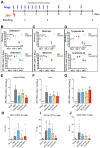Identification of Broad-Spectrum Antiviral Compounds by Targeting Viral Entry
- PMID: 30791609
- PMCID: PMC6410080
- DOI: 10.3390/v11020176
Identification of Broad-Spectrum Antiviral Compounds by Targeting Viral Entry
Abstract
Viruses are a major threat to human health and economic well-being. In recent years Ebola, Zika, influenza, and chikungunya virus epidemics have raised awareness that infections can spread rapidly before vaccines or specific antagonists can be made available. Broad-spectrum antivirals are drugs with the potential to inhibit infection by viruses from different groups or families, which may be deployed during outbreaks when specific diagnostics, vaccines or directly acting antivirals are not available. While pathogen-directed approaches are generally effective against a few closely related viruses, targeting cellular pathways used by multiple viral agents can have broad-spectrum efficacy. Virus entry, particularly clathrin-mediated endocytosis, constitutes an attractive target as it is used by many viruses. Using a phenotypic screening strategy where the inhibitory activity of small molecules was sequentially tested against different viruses, we identified 12 compounds with broad-spectrum activity, and found a subset blocking viral internalisation and/or fusion. Importantly, we show that compounds identified with this approach can reduce viral replication in a mouse model of Zika infection. This work provides proof of concept that it is possible to identify broad-spectrum inhibitors by iterative phenotypic screenings, and that inhibition of host-pathways critical for viral life cycles can be an effective antiviral strategy.
Keywords: Semliki Forest virus; Zika; alphaviruses; broad-spectrum antivirals; dengue; endocytosis; flaviviruses; host-targeted antivirals; phenotypic screening; virus entry.
Conflict of interest statement
The authors declare no conflict of interest.
Figures





Similar articles
-
Novel Nucleoside Analogues as Effective Antiviral Agents for Zika Virus Infections.Molecules. 2020 Oct 20;25(20):4813. doi: 10.3390/molecules25204813. Molecules. 2020. PMID: 33092055 Free PMC article.
-
Novel Broad-Spectrum Antiviral Inhibitors Targeting Host Factors Essential for Replication of Pathogenic RNA Viruses.Viruses. 2020 Dec 10;12(12):1423. doi: 10.3390/v12121423. Viruses. 2020. PMID: 33322045 Free PMC article.
-
A Novel Agonist of the TRIF Pathway Induces a Cellular State Refractory to Replication of Zika, Chikungunya, and Dengue Viruses.mBio. 2017 May 2;8(3):e00452-17. doi: 10.1128/mBio.00452-17. mBio. 2017. PMID: 28465426 Free PMC article.
-
Broad-spectrum agents for flaviviral infections: dengue, Zika and beyond.Nat Rev Drug Discov. 2017 Aug;16(8):565-586. doi: 10.1038/nrd.2017.33. Epub 2017 May 5. Nat Rev Drug Discov. 2017. PMID: 28473729 Free PMC article. Review.
-
Targeting viral entry as a strategy for broad-spectrum antivirals.F1000Res. 2019 Sep 12;8:F1000 Faculty Rev-1628. doi: 10.12688/f1000research.19694.1. eCollection 2019. F1000Res. 2019. PMID: 31559009 Free PMC article. Review.
Cited by
-
Identification of lysosome-targeting drugs with anti-inflammatory activity as potential invasion inhibitors of treatment resistant HER2 positive cancers.Cell Oncol (Dordr). 2021 Aug;44(4):805-820. doi: 10.1007/s13402-021-00603-2. Epub 2021 May 3. Cell Oncol (Dordr). 2021. PMID: 33939112 Free PMC article.
-
Evaluation of Phenol-Substituted Diphyllin Derivatives as Selective Antagonists for Ebola Virus Entry.ACS Infect Dis. 2022 May 13;8(5):942-957. doi: 10.1021/acsinfecdis.1c00474. Epub 2022 Mar 31. ACS Infect Dis. 2022. PMID: 35357134 Free PMC article.
-
Protamine Sulfate Is a Potent Inhibitor of Human Papillomavirus Infection In Vitro and In Vivo.Antimicrob Agents Chemother. 2022 Jan 18;66(1):e0151321. doi: 10.1128/AAC.01513-21. Epub 2021 Nov 1. Antimicrob Agents Chemother. 2022. PMID: 34723633 Free PMC article.
-
A randomized, double-blind, placebo-controlled trial of niclosamide nanohybrid for the treatment of patients with mild to moderate COVID-19.Nat Commun. 2025 Aug 1;16(1):7084. doi: 10.1038/s41467-025-62423-4. Nat Commun. 2025. PMID: 40750596 Free PMC article. Clinical Trial.
-
A molecular understanding of alphavirus entry.PLoS Pathog. 2020 Oct 22;16(10):e1008876. doi: 10.1371/journal.ppat.1008876. eCollection 2020 Oct. PLoS Pathog. 2020. PMID: 33091085 Free PMC article. Review.
References
Publication types
MeSH terms
Substances
Grants and funding
LinkOut - more resources
Full Text Sources
Other Literature Sources
Research Materials

